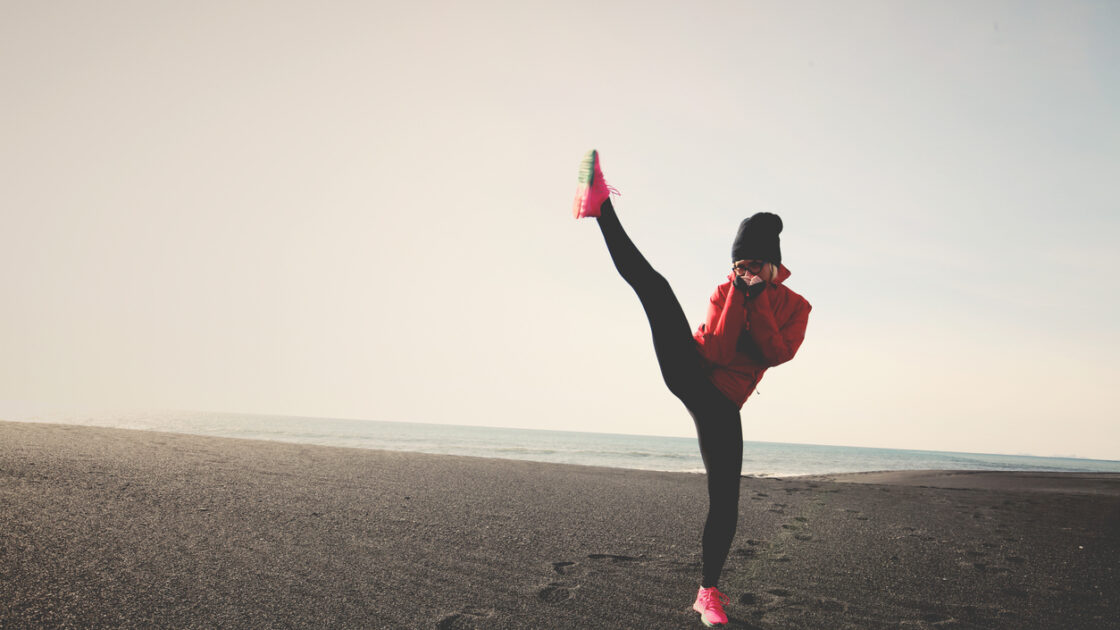Which One of These 9 Ass-Kicking Martial Arts Practices Do You Need Right Now?

There is no one perfect martial arts style, only the one (of more than 50 options) that fits your personal goals.
Even though martial arts have a combative nature to them, they are not necessarily meant to teach violence. Instead, they teach discipline and self-control while providing you with a unique exercise regimen that works muscles you never knew existed. Martial arts are as much for the health of the body as they are for that of the brain, regardless of the style you choose. Here’s what you need to know about nine popular martial arts styles before you choose and get started!
9 Martial Arts Styles
1. Aikido
Founded by Morihei Ueshiba and translated as “the way of the harmonious spirit”, Aikido is a modern Japanese martial art developed in the late 1920s. The practice focuses on bringing peaceful resolutions to situations involving conflict. It involves throwing, joint-locking, striking, and pinning techniques as well as the use of traditional Japanese weapons, like the sword, knife, and staff. Considered a means of transcending dualistic conflict and instead promoting the positive traits of the ideal warrior and self development, the technique consists of turning motions that redirect the momentum of an opponent’s attack.
2. Hapkido
Hapkido is a Korean martial art characterized by joint-locks, throws, and dynamic kicking techniques. It was adapted from Daitō-ryū Aiki-jūjutsu by Choi Yong-Sool. The technique consists of both long-rang and close-range fighting techniques that involves circular motion, redirection of force, and control of the opponent. It places an emphasis on footwork and body position to leverage strength as opposed to brute force.
3. Jiu-Jitsu
A Japanese martial art, Jiu-Jitsu is a form of unarmed conflict that was developed by Samurai warriors and is one of the oldest Japanese martial arts. The fighting technique relies on striking, throwing, restraining, evading, bending, and escaping. Brazilian Jiu-Jitsu, a variation of the Japanese combat style, focuses not on standing locks and throws but rather on ground techniques that allow a fighter to subdue an opponent twice his size.
4. Judo
Judo is an unarmed form of combat with Jiu-Jitsu roots that trains both the body and mind to gain leverage over an opponent. Judo was considered a much more practical approach to martial arts in comparison to Jiu-Jitsu. It does not focus on full contact wrestling and strikes, but instead on throwing the opponent off balance – more of a form of defense than a form of offense. The practice involves lifting and throwing an opponent to the ground and then the application of various chokeholds or joint-locks to force an opponent into submission. Judo does not involve kicking, punching, or striking. Instead, it uses the forces of balance, power, and movement that require immense physical and mental training. Even though those practicing Judo do not use strikes, they are trained to protect against them.
5. Karate
Karate was created by Sakukawa Kanga in the Ryukyu Kingdom, present day Japan. Already a popular martial art in the U.S., Karate is mostly characterized by striking, with the use of the hands, feet, elbows, and knees. Some forms of Karate involve joint-locking techniques and throwing and many Karate schools incorporate weapons training.
6. Kung Fu
Kung Fu refers to a Chinese martial arts technique that involves striking, kicking, grappling, throwing, and seizing and locking the joints. It resembles Karate, but Kung Fu is considered more circular and complex in style than Karate, which can be a stop-and-go and straightforward form of combat.
7. Muay Thai
Muay Thai is a hard martial art that uses fists, elbows, knees, and shins. Muay Thai is referred to as “the art of eight limbs” and can be traced back to the mid-16th century. It is a standing form of combat that involves the exchange of blows by way of a kick, punch, elbow, or block.
8. Taekwondo
The Korean martial art Taekwondo emphasizes head-height kicks, jumping and spinning kicks, and fast-kicking techniques. The practice was developed in the 1940s and 1950s and hinges on speed and agility.
9. Tai Chi
Perhaps the most peaceful and “slowest” of all martial arts, Tai Chi is an ancient Chinese martial art that is non-competitive in nature and used more as a practice to alleviate stress and anxiety. As a solo performance, Tai Chi involves slow movements that emphasize a straight spine, abdominal breathing, and a natural range of motion. With a partner, Tai Chi involves pushing hands and sense of sensitivity to the partner’s movements. The practice is best characterized as a moving form of yoga and meditation combined. While most practitioners use Tai Chi as a way to exercise the body and mind, others are interested in it as a combat modality.
Related on Organic Authority
5 Foods that Fight the Flu
A Fitness Program for Pets
Yin-Yang Fitness: The Best of Both Worlds

